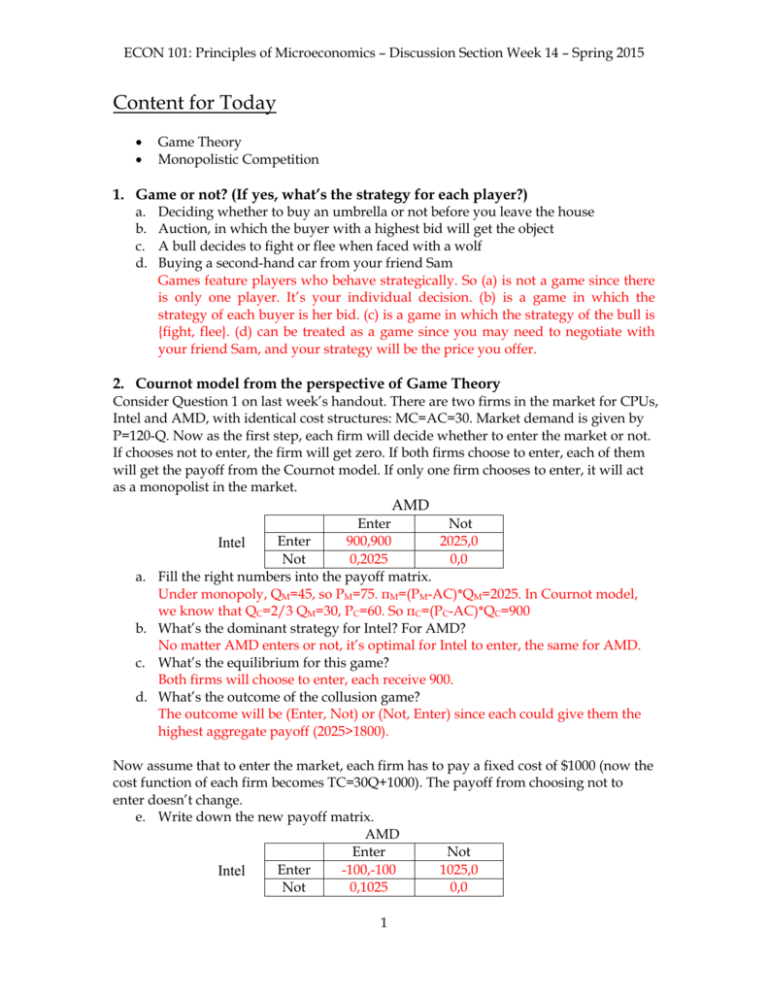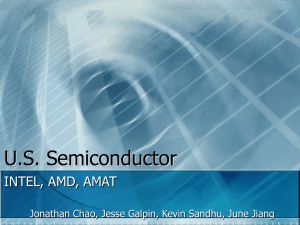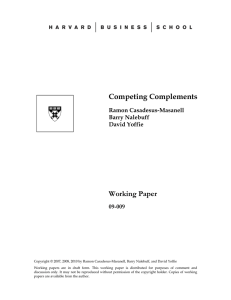Solutions 14
advertisement

ECON 101: Principles of Microeconomics – Discussion Section Week 14 – Spring 2015
Content for Today
Game Theory
Monopolistic Competition
1. Game or not? (If yes, what’s the strategy for each player?)
a.
b.
c.
d.
Deciding whether to buy an umbrella or not before you leave the house
Auction, in which the buyer with a highest bid will get the object
A bull decides to fight or flee when faced with a wolf
Buying a second-hand car from your friend Sam
Games feature players who behave strategically. So (a) is not a game since there
is only one player. It’s your individual decision. (b) is a game in which the
strategy of each buyer is her bid. (c) is a game in which the strategy of the bull is
{fight, flee}. (d) can be treated as a game since you may need to negotiate with
your friend Sam, and your strategy will be the price you offer.
2. Cournot model from the perspective of Game Theory
Consider Question 1 on last week’s handout. There are two firms in the market for CPUs,
Intel and AMD, with identical cost structures: MC=AC=30. Market demand is given by
P=120-Q. Now as the first step, each firm will decide whether to enter the market or not.
If chooses not to enter, the firm will get zero. If both firms choose to enter, each of them
will get the payoff from the Cournot model. If only one firm chooses to enter, it will act
as a monopolist in the market.
AMD
a.
b.
c.
d.
Enter
Not
Enter
900,900
2025,0
Intel
Not
0,2025
0,0
Fill the right numbers into the payoff matrix.
Under monopoly, QM=45, so PM=75. πM=(PM-AC)*QM=2025. In Cournot model,
we know that QC=2/3 QM=30, PC=60. So πC=(PC-AC)*QC=900
What’s the dominant strategy for Intel? For AMD?
No matter AMD enters or not, it’s optimal for Intel to enter, the same for AMD.
What’s the equilibrium for this game?
Both firms will choose to enter, each receive 900.
What’s the outcome of the collusion game?
The outcome will be (Enter, Not) or (Not, Enter) since each could give them the
highest aggregate payoff (2025>1800).
Now assume that to enter the market, each firm has to pay a fixed cost of $1000 (now the
cost function of each firm becomes TC=30Q+1000). The payoff from choosing not to
enter doesn’t change.
e. Write down the new payoff matrix.
AMD
Enter
Not
Enter
-100,-100
1025,0
Intel
Not
0,1025
0,0
1
ECON 101: Principles of Microeconomics – Discussion Section Week 14 – Spring 2015
f.
Does Intel have dominant strategy now? How about AMD?
No. Intel will choose Enter if AMD chooses Not, and choose Not if AMD chooses
Enter.
g. What’s the Nash Equilibrium in this scenario?
There are two NEs. One is (Not, Enter), and the other is (Enter, Not).
h. From your perspective, which NE is more likely to appear?
It depends on the reality. For example if Intel is well known for its aggressive
firm culture then AME may not be willing to choose entering, and (Enter, Not)
will be the final outcome. We call this equilibrium a focal point.
i. What’s the outcome if both firms play their max-min strategy?
For Intel, the worst outcome is -100 from choosing Enter and 0 from choosing
Not. So Intel will choose Not. Similarly, AMD will choose Not. So the outcome is
(Not, Not).
j. How could you change the payoff matrix above so that the equilibrium will be
like the one in prisoner’s dilemma? That is: at equilibrium both firms have to
accept a second-best outcome.
A possible change is as follows:
AMD
Enter
Not
Enter
-100,-100
1025,-200
Intel
Not
-200,1025
0,0
Now the first-best outcome is (Not, Not), but both firms will choose Enter. That’s
a prisoner’s dilemma.
We can see that small changes in parameters can lead to a totally different equilibrium
outcome.
3. Monopolistic Competition in the oatmeal market
Consider the market for oatmeal. There are many firms selling similar products, each
faced with a market demand curve: P=16-q. The total cost of each firm is given by
TC=q2+4, and marginal cost given by MC=2q.
a. What quantity and price will each firm choose?
MR=16-2q. Let MR=MC, then we have 16-2q=2q. So q=4, and p=16-q=12.
b. What’s the profit of each firm?
Revenue=p*q=48. Cost=16+4=20. So Profit is Revenue-Cost=28.
c. Is this market in long-run monopolistically competitive equilibrium? If not, what
needs to happen to bring it to LR equilibrium?
No, since each firm has positive profit. What will need to happen is the demand
curve will need to shift in because more firms would be entering the market and
taking away some of the demand.
2








